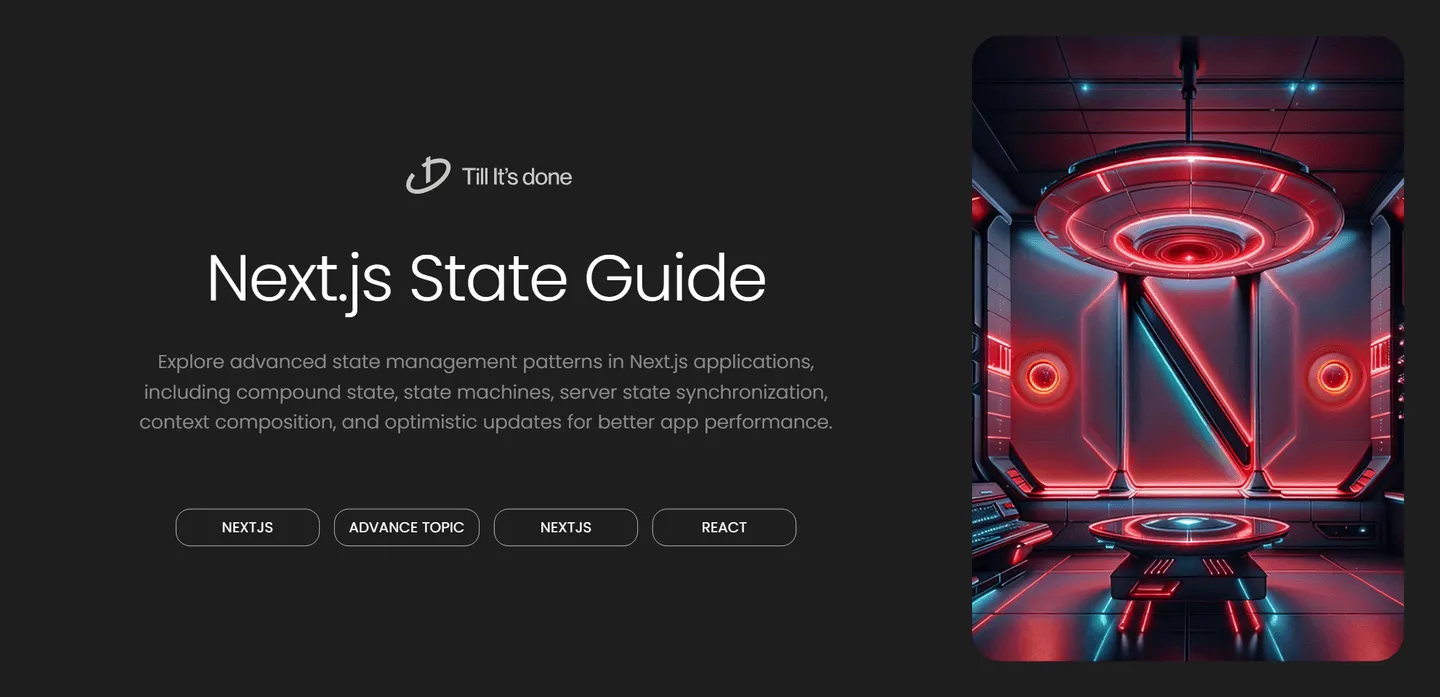- Services
- Case Studies
- Technologies
- NextJs development
- Flutter development
- NodeJs development
- ReactJs development
- About
- Contact
- Tools
- Blogs
- FAQ
Advanced Patterns for State Management in Next.js

Advanced Patterns for State Management in Next.js Apps

Managing state in modern Next.js applications can be challenging as your application grows in complexity. Let’s explore some advanced patterns that can help you maintain clean, scalable, and performant state management in your Next.js projects.
Understanding Client and Server State
One of the most crucial aspects of Next.js state management is distinguishing between client and server state. With the introduction of React Server Components, we need to be more mindful about where and how we manage our state.

Advanced State Management Patterns
1. Compound State Pattern
Instead of storing multiple related pieces of state separately, we can combine them into a single, cohesive state object. This approach reduces the number of state updates and makes our code more maintainable:
// Instead of thisconst [isLoading, setIsLoading] = useState(false);const [error, setError] = useState(null);const [data, setData] = useState(null);
// Use thisconst [state, setState] = useState({ status: 'idle', // idle | loading | success | error error: null, data: null});2. State Machines for Complex UI
When dealing with complex UI states, implementing a state machine can make your code more predictable and easier to debug. Libraries like XState work great with Next.js:
const todoMachine = createMachine({ initial: 'idle', states: { idle: { on: { FETCH: 'loading' } }, loading: { on: { SUCCESS: 'success', ERROR: 'error' } }, success: { on: { RETRY: 'loading' } }, error: { on: { RETRY: 'loading' } } }});3. Server State Synchronization
With Next.js 13+ and React Server Components, we can implement efficient server state synchronization:
async function PostsList() { const posts = await fetchPosts(); return <PostsClient initialData={posts} />;}
4. Context Composition Pattern
Instead of having one giant context provider, break down your state into smaller, focused contexts:
const AuthProvider = ({ children }) => { // Auth-specific state};
const ThemeProvider = ({ children }) => { // Theme-specific state};
const AppProvider = ({ children }) => ( <AuthProvider> <ThemeProvider>{children}</ThemeProvider> </AuthProvider>);5. Optimistic Updates Pattern
Implement optimistic updates to make your app feel more responsive:
const updateTodo = async (id, newData) => { // Update local state immediately setTodos(current => current.map(todo => todo.id === id ? { ...todo, ...newData } : todo ) );
try { // Perform actual API update await api.updateTodo(id, newData); } catch (error) { // Revert on error setTodos(previousTodos); showError(error); }};Best Practices and Tips
- Use React Query or SWR for server state management
- Implement proper error boundaries for state-related errors
- Keep state as close as possible to where it’s needed
- Use TypeScript for better state type safety
- Consider using Zustand for global state management
- Implement proper loading and error states
Remember that the best state management pattern depends on your specific use case. Don’t overcomplicate things if a simpler solution works well for your needs.

Conclusion
Advanced state management in Next.js requires careful consideration of where and how state is managed. By implementing these patterns appropriately, you can build more maintainable and scalable applications while providing a better user experience.
 สร้างเว็บไซต์ 1 เว็บ ต้องใช้งบเท่าไหร่? เจาะลึกทุกองค์ประกอบ website development cost อยากสร้างเว็บไซต์แต่ไม่มั่นใจในเรื่องของงบประมาณ อ่านสรุปเจาะลึกตั้งแต่ดีไซน์, ฟังก์ชัน และการดูแล พร้อมตัวอย่างงบจริงจาก Till it’s done ที่แผนชัด งบไม่บานปลายแน่นอน
สร้างเว็บไซต์ 1 เว็บ ต้องใช้งบเท่าไหร่? เจาะลึกทุกองค์ประกอบ website development cost อยากสร้างเว็บไซต์แต่ไม่มั่นใจในเรื่องของงบประมาณ อ่านสรุปเจาะลึกตั้งแต่ดีไซน์, ฟังก์ชัน และการดูแล พร้อมตัวอย่างงบจริงจาก Till it’s done ที่แผนชัด งบไม่บานปลายแน่นอน  Next.js สอน 14 ขั้นตอนเบื้องต้น: สร้างโปรเจกต์แรกใน 30 นาที เริ่มต้นกับ Next.js ใน 14 ขั้นตอนเพียงแค่ 30 นาที พร้อม SSR/SSG และ API Routes ด้วยตัวอย่างโค้ดง่าย ๆ อ่านต่อเพื่อสร้างโปรเจ็กต์แรกได้ทันทีที่นี่
Next.js สอน 14 ขั้นตอนเบื้องต้น: สร้างโปรเจกต์แรกใน 30 นาที เริ่มต้นกับ Next.js ใน 14 ขั้นตอนเพียงแค่ 30 นาที พร้อม SSR/SSG และ API Routes ด้วยตัวอย่างโค้ดง่าย ๆ อ่านต่อเพื่อสร้างโปรเจ็กต์แรกได้ทันทีที่นี่  วิธีสมัคร Apple Developer Account เพื่อนำแอปขึ้น App Store ทีละขั้นตอน อยากปล่อยแอปบน App Store ระดับโลก มาอ่านคู่มือสมัคร Apple Developer Account พร้อมเคล็ดลับ TestFlight และวิธีอัปโหลดที่ง่ายในบทความเดียวนี้ได้เลย
วิธีสมัคร Apple Developer Account เพื่อนำแอปขึ้น App Store ทีละขั้นตอน อยากปล่อยแอปบน App Store ระดับโลก มาอ่านคู่มือสมัคร Apple Developer Account พร้อมเคล็ดลับ TestFlight และวิธีอัปโหลดที่ง่ายในบทความเดียวนี้ได้เลย  TypeScript Interface คืออะไร? อธิบายพร้อมวิธีใช้และข้อแตกต่างจาก Type เรียนรู้วิธีใช้ TypeScript Interface เพื่อสร้างโครงสร้างข้อมูลที่ปลอดภัยและเข้าใจง่าย พร้อมเปรียบเทียบข้อดีข้อแตกต่างกับ Type ที่คุณต้องรู้ ถูกรวมเอาไว้ในบทความนี้แล้ว
TypeScript Interface คืออะไร? อธิบายพร้อมวิธีใช้และข้อแตกต่างจาก Type เรียนรู้วิธีใช้ TypeScript Interface เพื่อสร้างโครงสร้างข้อมูลที่ปลอดภัยและเข้าใจง่าย พร้อมเปรียบเทียบข้อดีข้อแตกต่างกับ Type ที่คุณต้องรู้ ถูกรวมเอาไว้ในบทความนี้แล้ว  Material-UI (MUI) คืออะไร อยากสร้าง UI สวยงามและเป็นมืออาชีพในเวลาอันรวดเร็วใช่ไหม มาทำความรู้จักกับ Material-UI (MUI) ที่ช่วยให้คุณพัฒนาแอปพลิเคชันบน React ได้ง่ายและดูดีในทุกอุปกรณ์
Material-UI (MUI) คืออะไร อยากสร้าง UI สวยงามและเป็นมืออาชีพในเวลาอันรวดเร็วใช่ไหม มาทำความรู้จักกับ Material-UI (MUI) ที่ช่วยให้คุณพัฒนาแอปพลิเคชันบน React ได้ง่ายและดูดีในทุกอุปกรณ์  เปรียบเทียบ 3 วิธีติดตั้ง install node js บน Ubuntu: NVM vs NodeSource vs Official Repo แบบไหนดีที่สุด? เรียนรู้วิธีติดตั้ง Node.js บน Ubuntu ด้วย NVM, NodeSource หรือ Official Repo เลือกวิธีที่เหมาะกับความต้องการของคุณ พร้อมเปรียบเทียบ เพื่อการพัฒนาที่มีประสิทธิภาพ!
เปรียบเทียบ 3 วิธีติดตั้ง install node js บน Ubuntu: NVM vs NodeSource vs Official Repo แบบไหนดีที่สุด? เรียนรู้วิธีติดตั้ง Node.js บน Ubuntu ด้วย NVM, NodeSource หรือ Official Repo เลือกวิธีที่เหมาะกับความต้องการของคุณ พร้อมเปรียบเทียบ เพื่อการพัฒนาที่มีประสิทธิภาพ! พูดคุยกับซีอีโอ
We'll be right here with you every step of the way.
We'll be here, prepared to commence this promising collaboration.
Whether you're curious about features, warranties, or shopping policies, we provide comprehensive answers to assist you.


